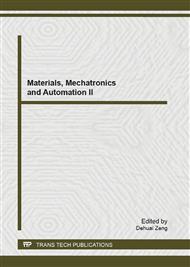[1]
Chen Liang-dong, Liu Jia, Yu Xue-feng, He Man, Pei Xiao-feng, Tang Zhao-you, Wang Qu-quan, Pang Dai-wen, Li Yan. The biocompatibility of quantum dot probes used for the targeted imaging of hepatocellular carcinoma metastasis[J]. Biomaterials, 2008, 29(31): 4170−4176.
DOI: 10.1016/j.biomaterials.2008.07.025
Google Scholar
[2]
Gao X H, Cui Y Y, Levenson R M, Chung L W K, Nie S M. In vivo cancer targeting and imaging with semiconductor quantum dots [J]. Nat Biotechnol, 2004, 22(8): 969−976.
DOI: 10.1038/nbt994
Google Scholar
[3]
Cai W B, Shin D W, Chen K, Gheysens O, Cao Q Z, Wang S X, Gambhir S S, Chen X Y. Peptide-labeled near-infrared quantum dots for imaging tumor vasculature in living subjects [J]. Nano Lett, 2006, 6(4): 669−676.
DOI: 10.1021/nl052405t
Google Scholar
[4]
Yu W W, Qu L H, Guo W Z, Peng X G. Experimental determination of the extinction coefficient of CdTe, CdSe, and CdS nanocrystals [J]. Chem Mater, 2003, 15(14): 2854−2860.
DOI: 10.1021/cm034081k
Google Scholar
[5]
Liu Y S, Sun Y H, Vernier P T, Liang C H, Chong S Y C, Gundersen M A. pH-sensitive photoluminescence of CdSe/ZnSe/ZnS quantum dots in human ovarian cancer cells [J]. J Phys Chem C, 2007, 111(7): 2872−2878.
DOI: 10.1021/jp0654718
Google Scholar
[6]
Kapitonov A M, Stupak A P, Gaponenko S V, Petrov E P, Rogach A L, Euchmulier A. Luminescence properties of thiol-stabilized CdTe nanocrystals [J]. J Phys Chem B, 1999, 103(46): 10109−10113.
DOI: 10.1021/jp9921809
Google Scholar
[7]
Liu Y F, Chen W, Joly A G, Wang Y Q, Pope C, Zhang Y B, Bovin J O, Sherwood P. Comparison of water-soluble CdTe nanoparticles synthesized in air and in nitrogen [J]. J Phys Chem B, 2006, 110(34): 16992−17000.
DOI: 10.1021/jp063085k
Google Scholar
[8]
Talapin D V, Rogach A L, Shevchenko E V, Kornowski A, Haase M, Weller H. Dynamic distribution of growth rates within the ensembles of colloidal II−VI and III−V semiconductor nanocrystals as a factor governing their photoluminescence efficiency [J]. J Am Chem Soc, 2002, 124(20): 5782−5790.
DOI: 10.1021/ja0123599
Google Scholar
[9]
Mattoussi H, Mauto J M, Goldman E R, Anderson G P, Sundar V C, Mikulec F V, BAWENDI M G. Self-assembly of CdSe−ZnS quantum dot bioconjugates using an engineered recombinant protein [J]. J Am Chem Soc, 2000, 122(49): 12142−12150.
DOI: 10.1021/ja002535y
Google Scholar
[10]
Gaponik N, Talapin D V, Rogach A L, Hoppe K, Shevchenko E V, Kornowski A, Eychmuller A, Weller H. Thiol-capping of CdTe nanocrystals: An alternative to organometallic synthetic routes [J]. J Phys Chem B, 2002, 106(29): 7177−7185.
DOI: 10.1021/jp025541k
Google Scholar
[11]
Zhang Hao, Zhou Zhen, Yang Bai. The influence of carboxyl groups on the photoluminescence of mercaptocarboxylic acid-stabilized CdTe nanoparticles [J]. J Phys Chem B, 2003, 107(1): 8−13.
DOI: 10.1021/jp025910c
Google Scholar
[12]
Talapin D V, Haubold S, Rogach A L, Kornowski A, Haase M, Weller H. A novel rganometallic synthesis of highly luminescent CdTe nanocrystals[J]. J Phys Chem B, 2001, 105(12): 2260−2263.
DOI: 10.1021/jp003177o
Google Scholar
[13]
Rogach A L, Katsikasl L, Kornowski A, Su D S, Eychmuller A, Weller H. Synthesis and characterization of thiol-stabilized CdTe nanocrystals [J]. Ber Bunsen-Ges Phys Chem, 1996, 100(11): 1772−1778.
DOI: 10.1002/bbpc.19961001104
Google Scholar
[14]
Yu W W, Wang Y A, Peng X G. Formation and stability of size-, shape-, and structure-controlled CdTe nanocrystals: Ligand effects on monomers and nanocrystals [J]. Chem Mater, 2003, 15(22): 4300−4308.
DOI: 10.1021/cm034729t
Google Scholar
[15]
Guo Jia, Yang Wu li, Wang Chang chun. Systematic study of the photoluminescence dependence of thiol-capped CdTe nanocrystals on the reaction conditions [J]. J Phys Chem B, 109(37): 17467−17473.
DOI: 10.1021/jp044770z
Google Scholar
[16]
Mandal A, Tamai N. Influence of acid on luminescence properties of thioglycolic acid-capped CdTe quantum dots [J]. J Phys Chem C, 2008, 112(22): 8244−8250.
DOI: 10.1021/jp801043e
Google Scholar
[17]
Wang Q, Kuo Y C, Wang Y W, Shing G, Ruengruglikit C, Huang Q R. Luminescent properties of water-soluble denatured bovine serum albumin-coated CdTe quantum dots [J]. J Phys Chem B, 2006, 110(34): 16860−16866.
DOI: 10.1021/jp062279x
Google Scholar
[18]
Deng Da wei, Qin Yuan-bin, Yang Xi, Yu Jun-sheng, Pan Yi. The selective synthesis of water-soluble highly luminescent CdTe nanoparticles and nanorods: The influence of the precursor Cd/Te molar ratio [J]. J Cryst Growth, 2006, 296(2): 141−149.
DOI: 10.1016/j.jcrysgro.2006.08.041
Google Scholar


